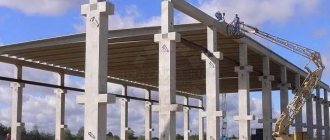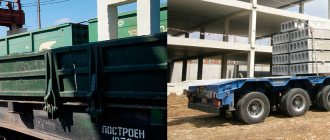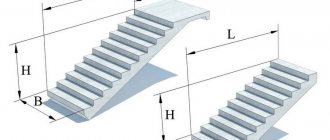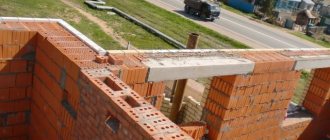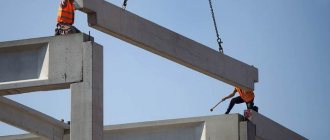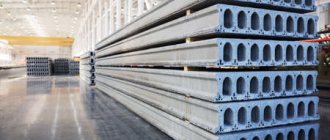Concrete drainage trays - GOST requirements for them
Concrete drainage trays are one of the most necessary parts in the construction and organization of systems for draining rainwater from buildings and in the organization of cable systems. Let's look at what types of trays there are and how they are used.
The strength and durability of concrete structures is ensured by the quality and water resistance of the brand of concrete that is used to fill the form. That is why the trays are based on a mixture of a grade no lower than M-200. In addition, the base is made of class A reinforcement rods or Bp-I grade wire base. The quality of the finished product is regulated by the requirements of GOST 21509-85.
Here are the main parameters that are specified in GOST:
- moisture resistance and ability to withstand frost;
- resistance to corrosion of metal parts and fittings;
- thickness and density of the concrete layer;
- general characteristics of the concrete mixture;
- resistance of the finished product to mechanical stress;
- the presence of voids in the cavity of the product.
Depending on the ratio of all the above parameters, there are three directions for using concrete drainage trays:
- drainage - function;
- for laying cables;
- to protect the heating main.
From the name of the product it is clear that they are used to organize drainage systems and drains. Functions performed by these products:
- Providing drainage, that is, removing excess moisture from the surrounding soil.
- Moisture redistribution. Removing water from the road surface and transporting it to the side of the road or slopes.
- Organization of channels for water outflow.
- Ensuring the outflow of storm water.
- Sewage function - connections of drainage systems with collectors.
Types of drainage trays
In accordance with GOST, there are three main types:
- in the form of a trapezoid;
- in the form of the letter P;
- in the form of a parabola.
At the same time, the first and second types can be either with a flat, flat internal base, or in the form of a round gutter. All the main characteristics, as well as the scope of their application, can be found out from the markings. It is especially important to study the markings when constructing or installing pipelines in difficult natural conditions. For example, when laying tracks in soil subject to seasonal fluctuations: swampy terrain, the presence of a clay layer, the presence of groundwater.
This also includes work that is carried out in the far north. The most important requirement here is resistance to low temperatures. Drainage trays are marked with the letter L, and two numbers indicate the series number and the maximum vertical load.
For ease of installation, trays come in two types: prefabricated and integral. Common models: length ranges from 0.72 meters to 6 meters, width from 0.4 meters to 1.84 meters, edge height from 0.38 meters to 1.32 meters.
The main purpose of these trays is to reliably protect the pipeline from corrosion, reduce heat loss and protect pipes from rodents. For sewerage and heating mains I use two types of trays:
- GOST Klp - these trays are covered with removable lids;
- GOST Kls - connection using channel fasteners.
The advantage of concrete trays over their brick counterparts:
- saving time and effort during installation due to the simplicity and integrity of the structure;
- significant cost reduction due to reduction of consumables;
- significant superiority in load-bearing capacity;
- ability to withstand sudden temperature changes and soil fluctuations.
For the use of sewer trays, the letter K is indicated, and for heating mains, the letter L. Let’s compare the cost of various concrete trays.
When buying a tray, you need to analyze in detail all the parameters of the product you have chosen: load, dimensions, assembly method and availability of a certificate.
The average price for one LK type tray measuring 350 mm by 350 mm and 2970 mm will be 1,700 rubles. It can be used to provide drainage systems. For example, during the construction of highways or bridges. Product L 2-8\2 with parameters 360 mm by 570 mm and 2970 mm will cost 2450 rubles. These trays are wider and are ideal for the construction of drainage systems for walking paths and drainage of rainwater from residential buildings.
LK 300. 4 5.30-1, has the following dimensions: 280 mm by 430 mm and 2990 mm. The price of this tray will be 3315 rubles. Such products are ideal for installing heating systems and laying cables. The most expensive option is L 10-8\2 with parameters of 550 mm by 1480 mm and 2970 mm. The cost of this product is 6600 rubles.
Additional materials:
Administrator
Rate the article (10 votes average score: 5.00 out of 5)
septikvdome.ru
Marking
When marking products, a alphanumeric designation system is used, which reflects the purpose of the blocks and their overall dimensions. The letter “L” denotes the tray itself, and “B” denotes the block structure of the telescopic drainage module. In the B3.300.1-504 series, products are marked “LB”. The index “L” can be supplemented by the standard dimensions of the element or characterize the type of tray:
- LPO tray ceiling with a hole;
- LT heating type;
- LDO – tray bottom with support type pillows;
- LU – corner product;
The indices at the end of the marking indicate the design or use features of the blocks:
- K – for sewer systems;
- I - ribbed type of construction;
- U – reinforced type.
Drainage trays are produced in a series of standardized products 3.407.1-157.
Reinforced concrete drainage trays
To drain water from roads and buildings, laying various types of communications and heating mains, special protective structures are used - trays made of high-quality anti-corrosion materials. An important advantage of reinforced concrete structures is their affordable price and significant time savings for construction and installation work. Familiarization with the classification of protective products will help you choose the right type and size of reinforced concrete trays to solve a specific engineering problem.
Features and purpose
The material is concrete with a density of at least 2400 kg/m3, reinforced with class A-I, A-II reinforcement or BI reinforcing wire. According to the manufacturing method, vibro-cast and vibro-pressed trays are distinguished. The second type is more resistant to the aggressive influence of the external environment; concrete on a vibrating press is dense, with a uniform structure and low water permeability. The walls of products are sometimes strengthened using galvanized steel linings.
The following requirements apply to trays, according to GOST 13015.0-83, 10268-80:
- concrete compressive strength – not less than M300;
- particle size of the concrete mixture aggregate – maximum 15 mm;
- Portland cement used - grade not lower than M400;
- the thickness of the concrete layer above the reinforcement is at least 15 mm;
- on the working surface there should be no sagging of concrete, sinks with a depth of more than 2 mm and a diameter of more than 3 mm;
- Shrinkage cracks no thicker than 0.1 mm may be present on the outer surface.
According to the functions they perform, protective concrete products are classified as follows:
1. drainage trays (type L, series 006.1-2/87) - used to create drainage, sewer and collector networks, used for transporting waste, subsoil and rainwater;
2. cable (type UBK, UBS, series of drawings 3.006.1-2.87) - protect cable channels (electrical, information, communications) and buses laid underground from damage, and are also reliable electrical insulators, preventing contact of high-voltage power lines with soil;
3. heating main trays (type L, series 006.1-8) – protect pipes filled with steam or hot water from heat loss, pressure and soil displacement, corrosion destruction, rodents;
4. drainage (MFBL) - for removing subsoil, melt and rain moisture from the foundations of houses, parking lots, pedestrian areas, highways, railway tracks;
5. road (type L, B; series 503.1-66) – remove water from roads to slopes;
6. intersleepers, intertracks (MPL, MSHL, series 501-68) - for draining water from railway lines.
Reinforced concrete drainage trays can perform various functions. Depending on the purpose of use, design and method of installation, they are divided into the following groups:
- storm drains - for collecting and draining large volumes of water generated during heavy rains;
- sewer - transport wastewater to collectors;
- telescopic - for collecting water on slopes and embankments and discharging it in a specially designated area; when constructing roads, they are used to create a transverse drainage system;
- culverts are gutters to ensure the gravity movement of water.
Types of trays
The industry produces products with rectangular, triangular, trapezoidal, elliptical, and parabolic cross-sections. The required form is selected depending on the technical problems being solved.
1. Square or rectangular. The most common type is a U-shaped box, resembling a gutter. Channel trays have this profile: bundles of cables are laid in them, the gaps are filled with concrete mixture, and waterproofing is done using mastic. In drainage systems, reinforced concrete culverts of rectangular cross-section are also most often used.
2. Triangular. This is the best option for storm sewers laid along roads; a triangular profile is preferable.
3. Trapezoidal. This form is characteristic of telescopic drainage trays: laid along the slope, they are inserted into each other. This allows you to withstand the water pressure that arises due to the difference in height.
4. Parabolic. They serve for water drainage, drainage, waste removal and are complemented by gratings made of cast iron, stainless steel, and plastic. Fences provide safety, serve an aesthetic role and act as a barrier to debris. Precast concrete trays with a parabolic cross-section are installed on a “cushion” of concrete, and the joints are sealed with mortar.
In each of these groups there are different modifications - solid, prefabricated, wide, narrow, additional.
Tray dimensions
The size of the product depends on its functional purpose, brand and design load. Length, width, height, wall thickness, volume vary. Conventionally, trays are divided into two categories: standard and non-standard. The most popular are GOST reinforced concrete products with the following dimensions:
- rectangular and square – 2970x420x360; 2970x1840x570; 2970x2780x1060 mm;
- trapezoidal – 2990x280x280; 2990x1180x430; 2990x2080x880 mm;
- parabolic – 720x420x360; 720x1160x1310; 720x2780x1060 mm.
It makes sense to order non-standard trays for large objects so that the cost of designing and manufacturing equipment is recouped. In this case, the main parameters must meet general technical requirements.
How are products labeled?
Each series has a specific designation, which is a combination of letters and numbers. The marking, regulated by state standards, encodes the type, size, design features, and load index. The following are several examples of reinforced concrete designations.
1. For insulation of heating mains (for example, L-12-8/2). The letter L with a series number (12) indicates the standard size, the number 8 indicates the design load in tf/m2. The number 2 after the stroke indicates that the length does not coincide with the standard dimension (6 m), but is ½ of this indicator - 3 m.
2. Culvert trays. They are marked with the letters B or LT. Series B includes products with the following dimensions: length – 1000-2500 mm, width – 375-750, height – 215-450 mm. The size of the LT is slightly larger: length – 1000-5980, width – 360-1700, height – 80-1000 mm.
3. Cable (for example, UBK.2A). The letter code indicates that the product is a universal cable, number 2 is the standard size (1990x500x160 mm). The letter A means that there are embedded elements (mesh and rods).
Price
Precast concrete products are the most affordable option for arranging a drainage or drainage system. The price depends on the design features, design load class, throughput (width of the hydraulic section), and manufacturing technology. It is advisable to purchase products from the manufacturer: in this case, you can avoid customs and logistics surcharges. To ensure the quality of the product, you should familiarize yourself with its certificate and quality guarantees from the supplier.
Average prices for trays sold in the Moscow region are shown in the table.
| Company | Marking | Dimensions, mm | Price, rubles |
| ZhBI-Center | L-1-7 | 1100x390x370 | 1 150 |
| L-300 | 2950x540x430 | 3 930 | |
| Plant ZhBI-11 | L-1-7 | 1100x390x370 | 750 |
| L-23-5 | 2300x540x300 | 3 070 | |
| KZHBI | L-1-8/2 | 740x420x360 | 3 800 |
| L-15-8/2 | 2980x1840x7200 | 15 200 | |
| Odintsovo reinforced concrete construction complex | Telescopic tray B-7 | 1500x890x400 | 3 350 |
| Road L-23-5 | 2360x530x300 | 3 110 | |
| MSHL-0.7 | 1500x400x800 | 3 920 |
stroitel-list.ru
Installation
Installation of standardized blocks is carried out on a pre-prepared surface in the form of a cushion of sand and crushed stone or special embeds. When installing telescopic structures, as well as during installation of covers, specialized bitumen mastic is used, which ensures tightness and the absence of moisture leaks, both from the outside and from the inside. The installation density is achieved by adjusting the expansion joints. Drainage elements can be laid underground or have an open appearance. Edge reinforced concrete products are installed on the surface and serve to direct water flows to the slopes. During installation, tray modules can be covered with filtration grids designed to prevent clogging of drain channels with large objects.
Purpose and scope
Reinforced concrete products are designed to drain melt and rainwater from highways, residential and other areas in order to prevent stagnation. High-strength concrete blocks are suitable for long-term use in conditions of high humidity.
The universal design allows the use of monolithic unified elements in the field of engineering and road construction, during the construction of tunnels, bridges, pipelines and overpasses. Trays are in demand to ensure the drainage of cold and hot water; they are used when installing heating mains, laying cables and pipelines to provide protection from external factors.
Trays are also used in open areas, including courtyards, park areas, stadiums, terraces, roads, industrial premises where precipitation or process water accumulates. In civil engineering, trays are used to drain water from the foundations of buildings; a special type of drainage blocks is in demand in railway and automobile construction. Unified elements are relevant for creating irrigation canals in agriculture and engineering hydraulic structures.
